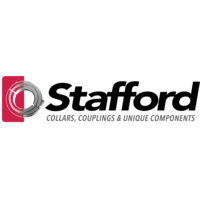 By Shelley Doherty
By Shelley Doherty
Shaft collars attach to shafts and other pieces of hardware to affix components in place. They can grip bearings in the right position, act as mechanical stops to halt rotary motion along the shaft, and ensure internal components don’t shift into misalignment. Because these components are so versatile, they come in a wide range of options for different industrial and commercial applications.
At Stafford, our experienced team of engineers specializes in creating sturdy, high-performance shaft collars for virtually any configuration. Learn more about the six most common types of shaft collars and their role in food processing, conveyance systems, and heavy-duty machinery.
TYPES OF SHAFT COLLARS
Depending on your machinery setup and your mounting needs, there are multiple different shaft collars available. These different varieties are classified based on how accessible the shaft is and the axial hold required. Clamp shaft collars, for example, clamp onto the shaft instead of requiring a set-screw for attaching to the shaft. Some of the most popular options include balanced, hinged, set screw, single split, double split, and threaded shaft collars. Take a deeper look at the different options:
Set Screw Shaft Collars: This collar is solid. It doesn’t have any relief cuts, and it doesn’t split into different sections. Instead, the set screw shaft collar is put into position and then affixed to the shaft by a tightened set screw that runs from the outer to the inner diameter of the collar.
Single Split Shaft Collars: This type of collar has one slot opening that allows for sliding the collar onto the shaft and then clamping it down. The slot can be opened and closed with a hex screw. The advantage of this model is that it’s easy to install, however, it doesn’t have the same uniform gripping strength as two-piece clamping collars and cannot be used where the shaft end is inaccessible.
Double Split Shaft Collars: These two-piece collars have two halves that are joined together by two socket cap screws. This allows for easy installation, as they can be installed either axially or radially. They also have a more uniform distribution of holding power than one-piece split collars.
Threaded Shaft Collars: These collars have an internally threaded clamp so they can be installed over a matching threaded shaft. Not only do the threads ensure the placement is exactly right, but the shaft is designed for supporting heavy axial loads. Threaded shaft collars are available in both single-split and double-split varieties.
Balanced Collars: Balanced collars are built to reduce vibration and shaking on a spinning shaft. They also help ensure an even distribution of the load weight. They feature a design similar to a double-split shaft collar, but the attaching screws sit opposite each other to provide even distribution.
Hinged Collars: Hinged collars have a triple-link hinge and a captive clamping mechanism. This allows the collar to open easily, be positioned, and then clamped shut. As a self-contained unit, there is never a risk of loose screws.
Each of these shaft collars can play a critical role in the integrity of your equipment or facility systems.
FOOD PROCESSING
In food processing systems, shaft collars can help at every stage of production and packaging. Shaft collars can help ensure consistent spacing between moving and weight-bearing elements, including supporting weight-bearing components and ensuring gears stay in the correct alignment during operation. Some key applications include:
- Guiding and stopping parts
- Mounting, aligning, and spacing component
At Stafford Manufacturing, we construct all of our shaft collars with a smooth, burr-free finish that mitigates the risk of buildup and bacteria. Our collars are available in several types of stainless steel, making them ideal for situations requiring corrosion resistance or the ability to withstand frequent washdowns.
- Affordable Cost
- Wide Variety of Materials
- Mounting Capabilities
- Variety of Styles to Suit your Needs
- Alignment Capabilities
- Easy Assembly
CONVEYING
Shaft collars are common in conveyor systems because they ensure all of the moving parts stay in alignment and can handle the weight of different loads. One common application of shaft collars in conveying is to keep the rollers consistently placed and aligned. Shaft collars from Stafford are built with sturdy, long-lasting materials that comply with today’s construction and industrial regulations.
HEAVY-DUTY MACHINERY
Heavy-duty machinery, like cranes and bulk industrial equipment, needs large, heavy-duty shaft collars that can ensure adequate weight-bearing capabilities. Collars from Stafford are built to secure shafts and axles, support weight, and stop movement as needed for smooth system operation.
Stafford Manufacturing
www.staffordmfg.com
Leave a Reply